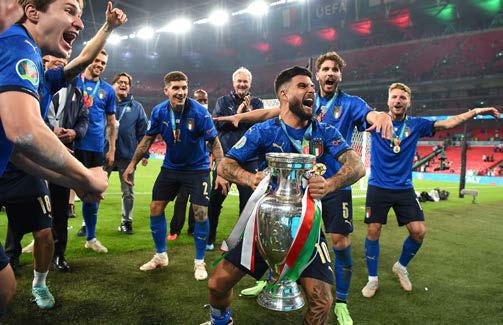CHAMPIONS LEAGUE
project
AS THE CHAMPIONS LEAGUE GETS SET TO TURN 30 IN ITS CURRENT GUISE, DAN ROBERTS ASKS WHETHER THE CHANGES HAVE BEEN FOR THE GREATER GOOD?
reboot II
t is almost 30 years since UEFA decided to do away with the old format of what used to be known as the European Cup. A major rebrand and rethink changed the old knockout competition between the champions of Europe’s leagues into the multi-stage, multi-format behemoth we know today. There have been a few changes over the years. It is fair to say that this season’s Champions League is nothing like the 1991-92 European Cup. But that is not to say that everyone thinks that the modern way is best – or even that every alteration has been celebrated and kept. There had been games between champions since the late 19th century, but the European Cup came into being for the 1955-56 season after a pair of French journalists persuaded UEFA to launch a competition based on the South America Championship of Champions that had been in existence since 1948. Only 16 clubs took part in that inaugural season, with Real Madrid beating Reims 4-3 in the final in Paris. The Spanish club then went on to win the first five finals and create an early domination of European football. Ties were played on a home and away basis, with the club scoring more goals on aggregate going through. The final was the only round of the competition decided by a one-off game. The main difference between the old European Cup and the modern Champions League was – somewhat ironically – that only the champions of each domestic league were invited to compete. The reigning European champions were also allowed to participate the following year, no matter whether they had won their domestic league or not. Critics of the modern competition point to the fact that it was only the best of the best that were able to truly call themselves champions of Europe. No club was able to finish fourth in their league and then go on to claim the European Cup the season after. The knockout format also meant that teams had little scope for playing poorly. They were not able to draw a few games and then sneak into the round of 16 like today’s clubs. A preliminary round was introduced very early on for the smaller club champions of Europe. But the knockout format stayed largely the same, with a first round consisting of 16 teams remaining in effect until the 1966-67 season. The first round was then extended to 32 teams, but due to some clubs receiving byes in some years it did mean that Ajax could win the European Cup in 1973 only playing four rounds of football and just seven matches in total. Even with this limited format, the bigger clubs of Europe tended to succeed. After Real Madrid’s early dominance, the title was shared by the likes of Benfica, Inter, Ajax and Bayern Munich. Feyenoord were probably the first
44
SOCCER360 MARCH • APRIL 2022
‘THE CHAMPIONS LEAGUE IS A MULTI-STAGE, MULTI-FORMAT BEHEMOTH’ ABOVE & RIGHT: Chelsea had to play 13 games en route to their underdog victory last year TOP LEFT: Real Madrid won the first ever European Cup in 1956 LEFT: Sergio Ramos with the Champions League trophy with the modern-day Real Madrid















